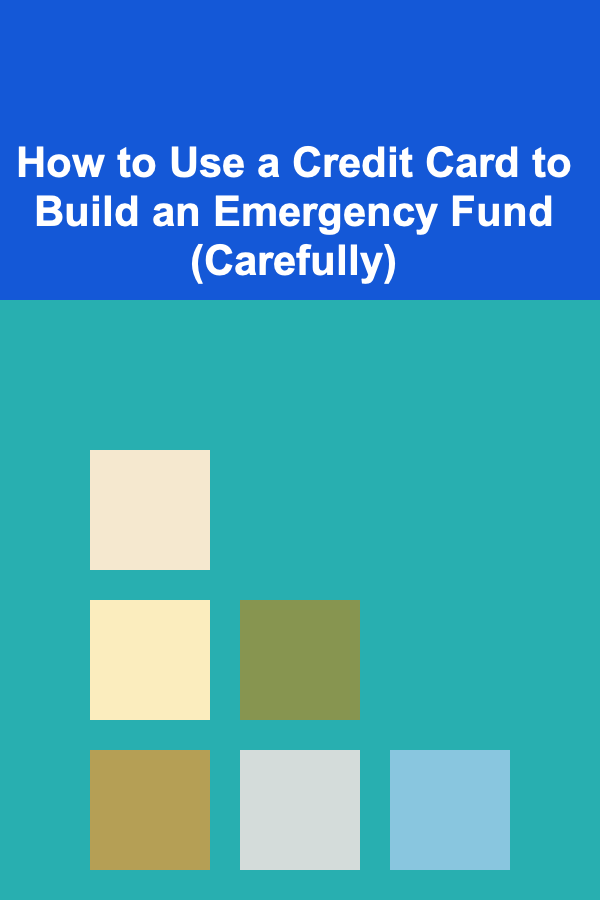
How to Use a Credit Card to Build an Emergency Fund (Carefully)
ebook include PDF & Audio bundle (Micro Guide)
$12.99$6.99
Limited Time Offer! Order within the next:

Building an emergency fund is one of the most essential steps you can take towards financial stability. This fund acts as a safety net for unexpected expenses such as medical bills, car repairs, or job loss. Traditional advice suggests saving cash in a separate account and building the emergency fund over time. However, in certain situations, a credit card can serve as a tool to help build this fund, but only if used with caution and care.
In this article, we will discuss how to use a credit card responsibly as a tool for building an emergency fund, when it makes sense to use a credit card for this purpose, and the potential risks and rewards of this strategy. We will also cover some key tips for balancing the need to save with the responsibility of managing credit card debt effectively.
Understanding the Importance of an Emergency Fund
Before diving into how a credit card can be used to build an emergency fund, it's important to understand why an emergency fund is crucial.
An emergency fund is a financial cushion designed to cover unexpected expenses that could disrupt your financial stability. These expenses may arise from:
- Medical emergencies: Sudden illnesses or accidents.
- Job loss: If you lose your job, an emergency fund can cover living expenses while you look for new work.
- Car repairs: Unforeseen vehicle breakdowns or accidents.
- Home repairs: Critical home repairs like plumbing issues, roof leaks, or appliance breakdowns.
Without an emergency fund, individuals often have to rely on credit cards, loans, or other forms of debt to cover these costs. This can lead to financial stress and an inability to manage debt effectively. Having an emergency fund provides peace of mind and financial security.
The Role of a Credit Card in Building an Emergency Fund
Credit cards are a useful financial tool when used correctly, but they are often seen as a liability due to the potential for high-interest rates and debt accumulation. So, how can a credit card help build an emergency fund?
A credit card can be used to cover immediate emergency expenses while you're in the process of building a dedicated emergency fund. This allows you to address urgent situations, like a car breakdown or medical bills, without draining your savings or taking on more debt.
However, there are key points to consider:
- Credit cards offer instant access to funds: In the case of an emergency, credit cards allow you to act quickly without waiting for a savings goal to be reached.
- Building an emergency fund with credit card use requires discipline: It's important to have a clear strategy to pay off the credit card balance as quickly as possible to avoid accumulating high-interest debt.
Using a credit card in this manner can be part of a broader strategy to build a strong financial foundation. However, the success of this strategy hinges on responsible usage.
When Does Using a Credit Card to Build an Emergency Fund Make Sense?
Using a credit card to cover emergency expenses can make sense in certain situations. It is important to distinguish between an actual emergency and non-urgent situations. Here are a few scenarios where using a credit card could be appropriate:
3.1 When You Have No Emergency Fund Yet
If you do not have any savings set aside for emergencies, a credit card can provide temporary relief. For instance, if you face an urgent expense and you cannot afford to pay it out of pocket, a credit card can act as a bridge. Once the immediate situation is resolved, you can prioritize paying off the credit card balance as you build your emergency fund.
3.2 When You Have a Plan to Pay Off the Balance Quickly
Using a credit card to build an emergency fund only works if you have a clear plan to pay off the balance within a reasonable time frame. This is especially true if you have access to a 0% APR credit card offer, which allows you to carry a balance without paying interest for an introductory period.
If you can quickly pay off the credit card balance, the cost of using the card for emergencies becomes minimal. The goal should be to keep your debt levels low and ensure that your emergency fund is built as quickly as possible.
3.3 When You Have Access to a Low-Interest or 0% APR Credit Card
If you can qualify for a credit card with a low-interest rate or a 0% APR offer on purchases, using a credit card for emergencies may be a practical solution. These offers typically last for 12-18 months, allowing you to spread out payments without incurring high interest charges. Just be sure to pay off the balance before the promotional period ends to avoid high-interest fees.
3.4 When You Have a Steady Income and Budgeting Discipline
Using a credit card to build an emergency fund can only work if you have a steady income and are disciplined about budgeting. You must ensure that you can pay off your credit card balance without compromising your other financial obligations. Having a well-structured budget will help you avoid using credit cards for non-essential purchases and focus on saving.
Risks of Using a Credit Card for an Emergency Fund
While a credit card can be a useful tool, there are significant risks involved. Using a credit card without careful planning can lead to financial hardship. Below are some of the key risks to consider:
4.1 High-Interest Rates and Debt Accumulation
The most significant risk of using a credit card for emergencies is the high-interest rates that can accumulate on any balance carried over month to month. If you're unable to pay off the credit card quickly, the interest charges can add up, leading to substantial debt. Over time, this could make it more difficult to manage your finances and reduce the benefits of using a credit card in the first place.
4.2 Impact on Credit Score
If you use a credit card for emergencies and carry a balance, it could negatively affect your credit score. High credit card balances relative to your credit limit can increase your credit utilization ratio, which is a key factor in determining your credit score. A high utilization ratio can hurt your credit score, making it harder to qualify for loans or other forms of credit in the future.
4.3 Risk of Using Credit Cards for Non-Essential Purchases
Credit cards can create a temptation to spend on things you don't necessarily need. Using a credit card as a financial crutch for everything from groceries to entertainment could derail your financial goals. This is why it is crucial to limit credit card usage to genuine emergencies and avoid using credit cards for everyday purchases.
4.4 The Potential for Overextending Your Credit
Using a credit card to cover emergencies can sometimes lead to overspending, especially if you aren't clear about what constitutes an "emergency." If you overuse your credit card or fail to stick to your budget, it can lead to higher debt levels and financial stress. It's important to evaluate each purchase carefully and make sure it truly qualifies as an emergency.
How to Build an Emergency Fund Without Relying on Credit Cards
Although credit cards can be a useful tool in emergencies, it's better to focus on building your emergency fund through traditional savings methods. Here are some strategies to help you build your emergency fund without relying on credit cards:
5.1 Create a Budget and Prioritize Savings
Start by creating a budget that allows you to allocate a portion of your income toward your emergency fund each month. Prioritize savings in your budget, making it a fixed expense that you contribute to before other discretionary spending.
5.2 Cut Back on Non-Essential Expenses
To free up more funds for your emergency fund, consider cutting back on non-essential expenses. This may include dining out less often, canceling subscription services, or finding ways to save on utilities. Every bit you save can go toward building your emergency fund.
5.3 Automate Savings
Set up an automatic transfer to a high-yield savings account dedicated to your emergency fund. Automating the process ensures that you consistently put money away and reduces the temptation to spend it elsewhere.
5.4 Increase Your Income
Consider ways to increase your income, such as taking on a side hustle or asking for a raise at work. Any additional money you earn can be put toward building your emergency fund faster.
Conclusion
Using a credit card to build an emergency fund can be a viable option in specific situations, but it must be approached with caution and responsibility. The key is to have a clear repayment strategy in place, avoid high-interest debt, and ensure that the use of credit cards is limited to true emergencies. Additionally, building an emergency fund through savings is a more sustainable long-term solution.
Incorporating both traditional savings methods and responsible credit card usage can help you establish a solid financial foundation. However, always be mindful of the risks involved and prioritize paying off any credit card balances as quickly as possible to avoid falling into debt.

10 Proven Tips for Saving on Group Tours and Travel Packages
Read More
How to Clean Your Home Naturally Without Harsh Chemicals
Read More
How to Save for a Vacation While Maintaining a Home Budget
Read More
How to Use Technology to Manage Your Rental Property
Read More
Maximizing Savings with Rebates and Incentives: A Complete Guide
Read More
10 Tips for Sales Managers New to Leadership Roles
Read MoreOther Products

10 Proven Tips for Saving on Group Tours and Travel Packages
Read More
How to Clean Your Home Naturally Without Harsh Chemicals
Read More
How to Save for a Vacation While Maintaining a Home Budget
Read More
How to Use Technology to Manage Your Rental Property
Read More
Maximizing Savings with Rebates and Incentives: A Complete Guide
Read More